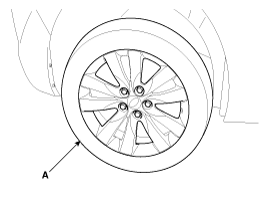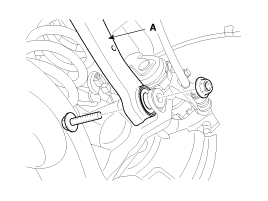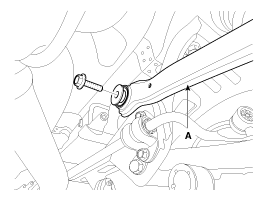Kia Cee'd: Rear Suspension System / Rear Upper Arm Repair procedures
Kia Cee'd JD Service Manual / Suspension System / Rear Suspension System / Rear Upper Arm Repair procedures
| Replacement |
| 1. |
Loosen the wheel nuts slightly.
Raise the vehicle, and make sure it is securely supported.
|
| 2. |
Remove the rear wheel and tire (A) from rear hub.
|
| 3. |
Loosen the bolt & nut and then remove the rear upper arm (A) from the
rear axle.
|
| 4. |
Loosen the bolt & nut and then remove the rear upper arm (A) from the
sub frame.
|
| 5. |
Install in the reverse order of removal.
|
| 6. |
Check the wheel alignment.
|
| Inspection |
| 1. |
Check the bushing for wear and deterioration.
|
| 2. |
Check the rear lower arm for deformation.
|
| 3. |
Check the coil spring and spring pad for deterioration and deformation.
|
| 4. |
Check for all bolts and nut.
|
 Rear Shock Absorber Repair procedures
Rear Shock Absorber Repair procedures
Replacement
1.
Loosen the wheel nuts slightly.Raise the vehicle, and make sure it is
securely supported.
2.
Remove the rear wheel a ...
 Rear Lower Arm Repair procedures
Rear Lower Arm Repair procedures
Replacement
1.
Loosen the wheel nuts slightly.
Raise the vehicle, and make sure it is securely supported.
2.
Remove the rear wh ...
Other information:
Kia Cee'd JD Service Manual: Variable Intake Solenoid(VIS) Actuator Repair procedures
Removal and Installation
1.
Disconnect the battery nagative terminal.
2.
Disconnect the lever (A) and hose (B).
3.
Loosen the mounting bolts and then remove the VIS actuator (C).
...
Kia Cee'd JD Service Manual: ESP Control Module Repair procedures
Removal [LHD]
1.
Turn the ignition switch OFF.
2.
Pull up the lock of the HECU connector (A) , then disconnect the connector.
3.
Remove the brake fluid from the master cylinder reservoir with a ...
© 2017-2025 www.kceed.com





